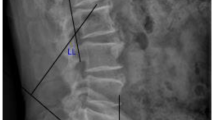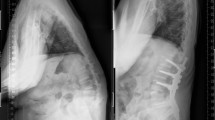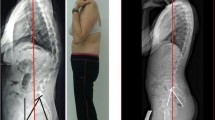Abstract
Purpose
Adult spinal deformity (ASD) classification showing that ideal pelvic incidence minus lumbar lordosis (PI-LL) value is within 10° has been received widely. But no study has focused on the optimum level of PI-LL value that reflects wide variety in PI among patients. This study was conducted to determine the optimum PI-LL value specific to an individual’s PI in postoperative ASD patients.
Methods
48 postoperative ASD patients were recruited. Spino-pelvic parameters and Oswestry Disability Index (ODI) were measured at the final follow-up. Factors associated with good clinical results were determined by stepwise multiple regression model using the ODI. The patients with ODI under the 75th percentile cutoff were designated into the “good” health related quality of life (HRQOL) group. In this group, the relationship between the PI-LL and PI was assessed by regression analysis.
Results
Multiple regression analysis revealed PI-LL as significant parameters associated with ODI. Thirty-six patients with an ODI <22 points (75th percentile cutoff) were categorized into a good HRQOL group, and linear regression models demonstrated the following equation: PI-LL = 0.41PI–11.12 (r = 0.45, P = 0.0059).
Conclusions
On the basis of this equation, in the patients with a PI = 50°, the PI-LL is 9°. Whereas in those with a PI = 30°, the optimum PI-LL is calculated to be as low as 1°. In those with a PI = 80°, PI-LL is estimated at 22°. Consequently, an optimum PI-LL is inconsistent in that it depends on the individual PI.


Similar content being viewed by others
References
Schwab F, Smith VA, Biserni M, Gamez L, Farcy JP, Pagala M (2002) Adult scoliosis: a quantitative radiographic and clinical analysis. Spine 27:387–392
Gelb DE, Lenke LG, Bridwell KH, Blanke K, McEnery KW (1995) An analysis of sagittal spinal alignment in 100 asymptomatic middle and older aged volunteers. Spine 20:1351–1358
Glassman SD, Bridwell K, Dimar JR, Horton W, Berven S, Schwab F (2005) The impact of positive sagittal balance in adult spinal deformity. Spine 30:2024–2029
Lafage V, Schwab F, Patel A, Hawkinson N, Farcy JP (2009) Pelvic tilt and truncal inclination: two key radiographic parameters in the setting of adults with spinal deformity. Spine 34:E599–E606
Protopsaltis T, Schwab F, Bronsard N, Smith JS, Klineberg E, Mundis G et al (2014) The T1 pelvic angle, a novel radiographic measure of global sagittal deformity, accounts for both spinal inclination and pelvic tilt and correlates with health-related quality of life. J Bone Joint Surg Am 96:1631–1640
Schwab F, Farcy JP, Bridwell K, Berven S, Glassman S, Harrast J et al (2006) A clinical impact classification of scoliosis in the adult. Spine 31:2109–2114
Duval-Beaupère G, Schmidt C, Cosson P (1992) A barycentremetric study of the sagittal shape of spine and pelvis: the conditions required for an economic standing position. Ann of Biomed Eng 20:451–462
Legaye J, Duval-Beaupère G, Hecquet J, Marty C (1998) Pelvic incidence: a fundamental pelvic parameter for three-dimensional regulation of spinal sagittal curves. Eur Spine J 7:99–103
Boulay C, Tardieu C, Hecquet J, Benaim C, Mouilleseaux B, Marty C et al (2006) Sagittal alignment of spine and pelvis regulated by pelvic incidence: standard values and prediction of lordosis. Eur Spine J 15:415–422
Schwab F, Ungar B, Blondel B, Buchowski J, Coe J, Deinlein D et al (2012) Scoliosis research society-Schwab adult spinal deformity classification: a validation study. Spine 37:1077–1082
Rothenfluh DA, Mueller DA, Rothenfluh E, Min K (2015) Pelvic incidence-lumbar lordosis mismatch predispose to adjacent segment disease after lumbar spinal fusion. Eur Spine J 24:1251–1258
Cho W, Mason JR, Smith JS, Shimer AL, Wilson AS, Shaffrey CI (2013) Failure of lumbopelvic fixation after long construct fusion in patients with adult spinal deformity: clinical and radiographic risk factors. J Neurosurg Spine 19:445–453
Le Huec JC, Aunoble S, Philippe L, Nicolas P (2011) Pelvic parameters: origin and significance. Eur Spine J 20:S564–S571
Roussouly P, Gollogly S, Noseda O, Berthonnaud E, Dimnet J (2006) The vertical projection of the sum of the ground reactive forces of a standing patient is not the same as the C7 plumb line: a radiographic study of the sagittal alignment of the 153 asymptomatic volunteers. Spine 31:E320–E325
Berthonnaud E, Dimnet J, Roussouly P, Labella H (2005) Analysis of the sagittal balance of the spine and pelvis using shape and orientation parameters. J Spinal Disord Tech 18:40–47
Schwab F, Patel A, Ungar B, Farcy JP, Lafage V (2010) Adult spinal deformity-postoperative standing imbalance: how much can you tolerate? An overview of key parameters in assessing alignment and planning corrective surgery. Spine 35:2224–2231
Yamada K, Abe Y, Yanagibashi Y, Hyakumachi T, Satoh S (2015) Mid- and long-term clinical outcomes of corrective fusion surgery which did not achieve sufficient pelvic incidence minus lumbar lordosis value for adult spinal deformity. Scoliosis 10:S17
Horton WC, Brown CW, Bridwell KH, Glassman SD, Suk SI, Cha CW (2005) Is there an optimal patient stance for obtaining a lateral 36″ radiograph? Acritical comparison of three techniques. Spine 30:427–433
Schwab F, Blondel B, Bess S, Hostin R, Shaffrey CI, Smith JS (2013) Radiographical spinopelvic parameters and disability in the setting of adult spinal deformity. Spine 38:E803–E812
Boissiere L, Bourghli A, Vital JM, Gille O, Obeid I (2013) The lumbar lordosis index: a new ratio to detect spinal malalignment with a therapeutic impact for sagittal balance correction decisions in adult scoliosis surgery. Eur Spine 22:1339–1345
Lafage V, Schwab F, Vira S, Patel A, Ungar B, Farcy JP (2011) Spino-pelvic parameter after surgery can be predicted. Spine 36:1037–1045
Rose PS, Bridwell KH, Lenke LG, Cronen GA, Mulconrey DS, Buchowski JM et al (2009) Role of pelvic incidence, thoracic kyphosis, and patient factors on sagittal plane correction following pedicle subtraction osteotomy. Spine 34:785–791
Roussouly P, Pinherio-Franco JL (2011) Biomechanical analysis of the spino-pelvic organization and adaptation in pathology. Eur Spine J 20:S609–S618
Legaye J, Duval-Beauere G (2005) Sagittal plane alignment of the spine and gravity: a radiological and clinical evaluation. Acta Orthop Belg 71:213–220
Lafage V, Ames C, Schwab F, Klineberg E, Akbania B, Smith J et al (2012) Change in thoracic kyphosis negatively impact sagittal alignment after lumbar pedicle subtraction osteotomy. Spine 37:E180–E187
Berjano P, Langella F, Ismael M-F, Damilano M, Scopetta S, Lamertina C (2014) Successful correction of sagittal imbalance can be calculated on the basis of pelvic incidence and age. Eur Spine J 23:S587–S596
Author information
Authors and Affiliations
Corresponding author
Ethics declarations
Conflict of interest
None.
Rights and permissions
About this article
Cite this article
Inami, S., Moridaira, H., Takeuchi, D. et al. Optimum pelvic incidence minus lumbar lordosis value can be determined by individual pelvic incidence. Eur Spine J 25, 3638–3643 (2016). https://doi.org/10.1007/s00586-016-4563-8
Received:
Revised:
Accepted:
Published:
Issue Date:
DOI: https://doi.org/10.1007/s00586-016-4563-8




